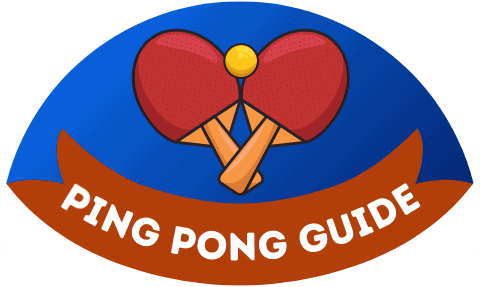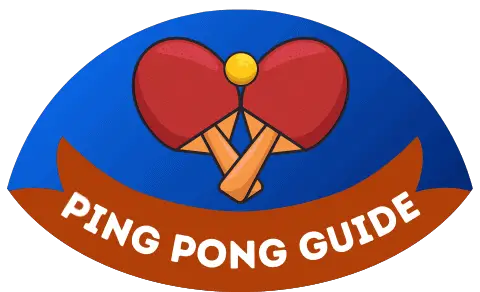Isn’t it crazy sometimes that every sport, no matter how great, has evolved from a simple gimmick? It’s no different with table tennis. So this post is about the story of how the idea of “Roomtennis” evolved into the sport we know today.
The most important thing in a nutshell
An early form of table tennis emerged in England in the 1870s from the idea of bringing the popular game of tennis indoors. A short time later, the first game sets were available for purchase, and the name Ping Pong was coined. In the course of time, the game was developed further and further and even became an Olympic sport in 1988.
This was of course a very summarized story. There are many more details that I will go into throughout the article. Here is a quick overview if you are looking for something in particular:
How and where was table tennis invented?
Origin
The first time an early form of table tennis was documented was in 1874 in England. There are also voices that say that the origin is in India, but the fact that the sport was first recorded in writing in England determined it as the origin country.
But how did it originate? As the name suggests, it has something to do with traditional tennis. This game was popular in the 1870s, especially among the English upper class or aristocracy. The only problem was that tennis was played outdoors and that was not always possible in the familiar English rainy weather.
So the logical step was to move the game inside. Of course, there wasn’t enough space there for a tennis court. So the tables became the courts and the nets were initially strings. It is said that the game was played with shuttlecocks, books, and even pans, and a rubber ball or a cork ball served as playing equipment. At that time the game was simply called Indoor tennis.
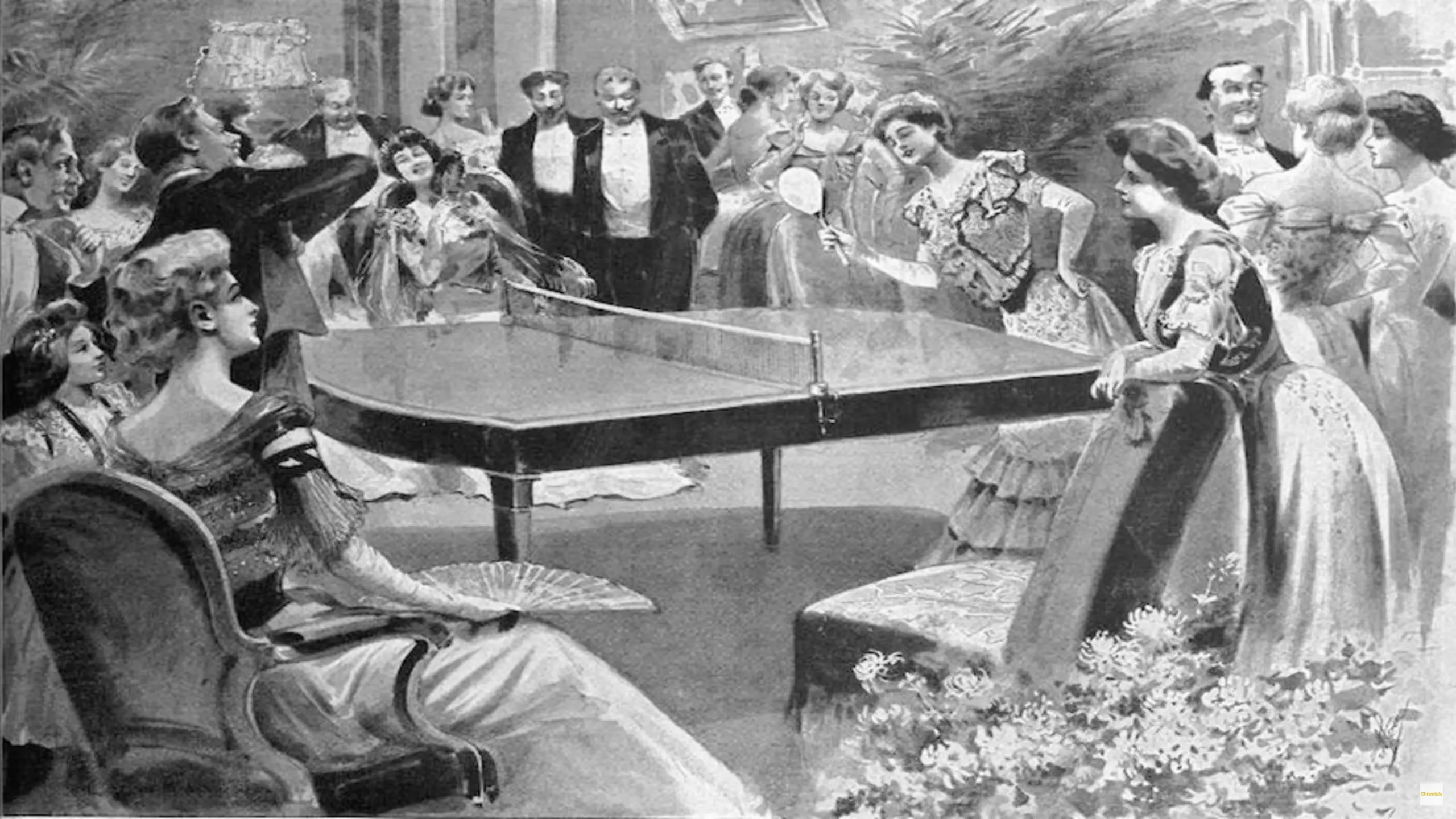
then in 1875 the Englishman James Gibb the first rules of the game were written down and published. The way to the real sport was paved.
The evolution to the official sport
Evolution of the name
Roomtennis became more and more popular and the game developed continuously. In time, the well-known term “ping pong” replaced the name roomtennis, which was more appropriate due to the characteristic sound of the ball .
The growing popularity and simple design of the game soon attracted resourceful entrepreneurs. Game accessories were produced by different brands and each tried to establish its name.
So if things had gone differently, table tennis today could also be called Whiff Waff, Flim Flam, or Gossima 😁. Initially, however, the name Ping Pong prevailed, which was quickly patented and registered as a trademark.
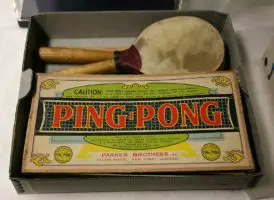
This legal hurdle is probably also the reason why we talk about table tennis today when we mean the sport and use “ping pong” more colloquially for the recreational game. In the meantime, ping pong and table tennis are actually different sports .
First competitions and foundation of the first clubs
Around the turn of the century, the first competitions and clubs were formed. The first national championship took place in 1897 in what is now Hungary. A little later, the 1st Berlin Tennis and Ping-Pong Society were founded in Berlin (today Tennis Borussia Berlin).
The first club in England was founded in 1900. A year later, the national Ping Pong Association was formed, which merged with the Table Tennis Association a little later, due to trademark problems with the name. The foundation stone for table tennis as we know it today was laid.
in 1902, the first international tournament was held in Vienna:

How did table tennis come to Asia (specifically China)?
As everyone knows, Asian players and especially Chinese players dominate the table tennis landscape today. But how did the sport actually get there?
As early as 1899, the early form of table tennis found its way to Japan and from there to China, Hong Kong, and Korea. From the very beginning, the game was extremely popular and consequently quickly developed into a popular sport.
Now let’s take a look at how the competitions we know today developed from this.
The history of official table tennis competitions
In order for competitions to take place, it was first necessary to have associations that organized the competitions. Here is an overview of the most important ones:
- English Table Tennis Association (ETTA) – founded in 1901
- German Table Tennis Association (DTTB) – founded in 1925
- International Table Tennis Association (ITTF) – founded in Berlin in 1926
What can be easily seen is that England and Germany had crucial roles in the development of the sport.
When was the first official table tennis match?
The first official match that was documented (according to Wikipedia) was just the first match at the national championship in Hungary in 1897. The first German tournament was held in 1901.
When was the First World Table Tennis Championship held?
The foundation of the International Table Tennis Federation (ITTF) was also the starting signal for the first World Table Tennis Championship, which was held in London in 1926.
Curiously, the tournament had actually only been planned as a European championship. However, 8 players from India then took part, making it a world championship.
By the way, there were competitions for both men and women. In addition, there were already the different modes singles, Doubles, and mixed.
Since when has the German Table Tennis Bundesliga existed?
The Bundesliga was founded in the 60s. The first season started in 1966 and ended in 1967 with TuSa Düsseldorf at the top.
Since when is table tennis Olympic?
Interestingly, table tennis has only been represented since the 1988 Olympics in Seoul. Thus, there were not even 10 Olympiads featuring table tennis. This was because the ITTF and the Olympic Committee could not agree for a long time.
Though, the idea that table tennis should become Olympic came up already in the 30s. It was even debated whether it should be held during the Winter Games. At that time, however, the ITTF president blocked this.
Table tennis was thus not officially recognized by the IOC until 1981
How has table tennis changed over time?
Since the first official matches at the turn of the century, the sport has of course developed extremely. New rules for the game itself or for the equipment have been issued again and again. The style of play has also changed dramatically. Let’s take a look at the most important changes.
Further development of rackets, balls, and tables
Balls
After rubber balls and cork had to be used for the original roomtennis, the celluloid ball was introduced quite early. This material lasted for a very long time. Then, only in 2000, it was decided to increase the diameter of the balls from 38 mm to 40 mm, until in 2014 only plastic balls were allowed by the ITTF.
By the way, only the balls approved and tested by the ITTF are marked with 3 stars.
Rackets
Rackets have also evolved from the original ping pong rackets. Since there were no strict rules at first, players could get creative
In the 1930s, Hungarian table tennis legend Victor Barna coined the game with a simple pimple rubber without a sponge base. Until the 1950s, this surface was the leading one.
Here a little video insight into table tennis in the 30s with Victor Barna Video
It was not until 1951 that the first player competed with a racket with a flexible sponge. Due to the increased catapult effect the racket was able to generate more speed. This was also the beginning of spin-heavy play.
in 1959, it was the Chinese players who combined the sponge and pimple rubbers and coined the “pimple-out” rubber. A little later, the Japanese players developed the so-called sandwich rubbers and thus also the modern topspin. These are the smooth “pimple-inside” rubbers that we still know today.
Because of the meanwhile very spin-heavy rubbers, it didn’t take long until there was an answer to this as well. in 1980, the first anti-spin rubbers came into use, which could completely equalize the opponent’s spin.
Since the different sides of a racket could now have such different properties, it was finally introduced in 1983 that the two rubbers had to have different colors in order to be distinguishable. in 1985, it was also established that the colors must be black and red.
Since 2021, four other colors are allowed for the surface
Table Tennis Tables
The most important development in the case of the tables concerns, first of all, the dimensions. Because to date, it is not specified what material a table must be made of. It is only important that it complies with the prescribed dimensions and properties
While the first tables were shorter and the nets higher, this was changed over time, because otherwise, the players acted too cautiously. Thus, the first rally at the 1936 World Cup lasted a beaten 2 hours and 10 minutes!
So the plate length was increased from 184 cm to 274 cm and the net height was reduced to 15.25 cm to simplify the game
The most important rule changes
In addition to the material, there were also always decisive rule changes that influenced the development of the game. Here is an overview of the most important ones
| Year | Rule |
| 1902 | Introduction of the serve, which must first touch the player’s own side of the board. |
| 1937 | Introduction of the alternating method |
| 1983 | Establishment of the different rubber colors |
| 2000 | Increase of the ball diameter to 40 mm |
| 2001 | Change of the scoring method: Set length to 11 |
| 2002 | New rule for the serve: the ball must not be covered and must be thrown at least 16 centimeters straight in the air. |
Evolution of the style of play
As a result of the rule changes and material changes described above, the style of play has naturally changed over time.
In the early days of the sport, players were more concerned with simply getting the ball back to the plate, which created those extremely long rallies. Over time, spin became more important and the common style of play became more aggressive.
In the 1950s, Japanese players surprised their opponents for the first time with the now-famous penhold grip, shaping the topspin game that is still popular today.
Table Tennis Legends – Who are the most iconic players?
Now, of course, it’s worth taking another look at the most formative players in history. In order not to become too extravagant, I have limited myself here to my top 5
Victor Barna

Victor Barna is considered one of the most influential table tennis players in history. Many even refer to him as “Mr. Table Tennis”. The Hungarian player won a total of 22 titles and 41 medals at the World Table Tennis Championships between 1930 and 1954.
He thus left his mark precisely on the period before the more modern sponge rubbers became popular. For he was very successful, especially with the simple pimple rubber.
Jan-Ove Waldner

The “Mozart of table tennis” is Jon-Ove Waldner. The Swede was twice the world champion and won Olympic gold in 1992. But he also achieved legend status because he was still playing in the German Bundesliga in 2012 at the age of 46.
Deng Yaping

Deng Yaping is the most successful female table tennis player of all time. She not only became world champion 3 times, but also won Olympic gold for China 4 times.
Ma Long
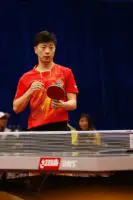
Ma Long is not only the most famous table tennis player in the world, but is also considered the best of all time. He especially made his mark in the 2010s and won Olympic gold in both 2016 and 2021. In addition, he won the World Championship three times.
Timo Boll
I can’t write this article without mentioning Timo Boll. Looking only at the pure successes, there may be other players I could have mentioned, but his achievement lies in the fact that he managed to stand up to the Chinese superiority in table tennis. Incidentally, this also makes him one of the best-known Germans in China
At times, Boll was even 1st on the world ranking list in 2003, 2011, and 2018. You can also see from this how long he has been playing at the highest level
And of course, he has also achieved important successes. He has won bronze at the World Championships 2 times and even won the World Cup 2 times. At the Olympics, Bal also won silver with the German team 2 times

Thank you, if you have read the post to here 😁 You seem to be as interested in the sport as I am. Even if history can a bit dry, I hope you enjoyed reading it. Because that’s what it’s always about!
Fun at the game 🏓
